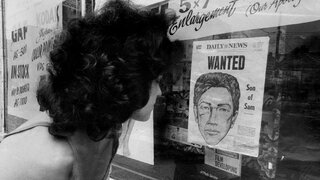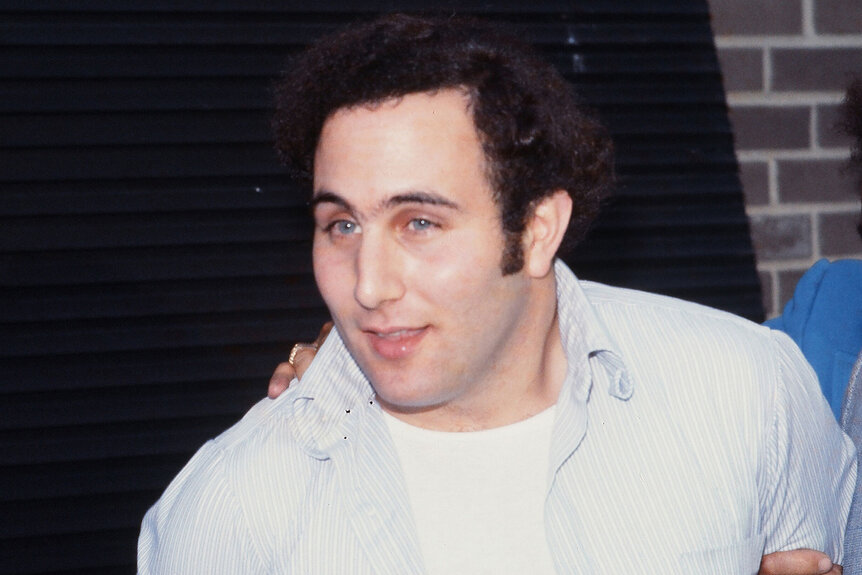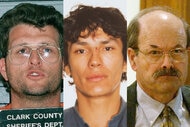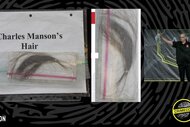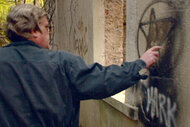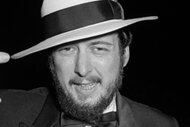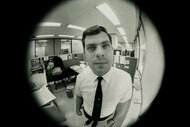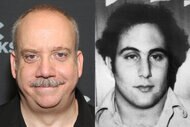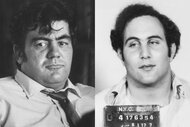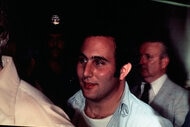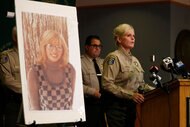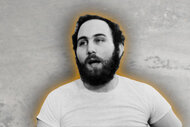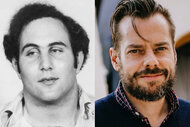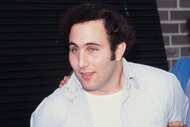Create a free profile to get unlimited access to exclusive videos, breaking news, sweepstakes, and more!
Who Is David Berkowitz, The 'Son Of Sam'?
“It had absolutely everything going for it as a tabloid perfect storm," said former Daily News editor Sam Roberts of the madness that enveloped Manhattan as the so-called "Son of Sam" stalked the streets.
David Berkowitz terrorized New York in the mid-1970s with a spree of senseless violence that only became more frightening once he was caught, and explained his bizarre motivation.
Prior to his capture, Berkowitz left letters at some of the crime scenes, taunting the investigators who had yet to capture him. These letters were ultimately shared with the public, revealing Berkowitz's twist thoughts and leading some to believe that he was possessed by a demonic entity.
In addition, he signed the letters as the "Son of Sam," giving news outlets a new name to refer to the coldhearted killer.
But who was the man behind the killings? Keep reading to learn more.
RELATED: How the Son of Sam Terrorized NYC and The Evidence That Led to His Capture
Who Is David Berkowitz?
On June 1, 1953, Richard David Falco was born to a mixed Italian and Jewish family, but he was adopted by Nathan and Pearl Berkowitz, Jewish hardware store owners, in New York City, days later, according to Biography.com.
"He was a strikingly good-looking boy — nice and tall and with brown wavy hair. But he was hyperactive and his parents had a difficult time coping with him. The kids would complain he'd hit them without provocation," said Lillian Goldstein, a neighbor of the Berkowitz family, in a 1977 Daily News article that also noted a young Berkowitz's victimization at the hands of bullies who insulted his Jewish heritage.
Berkowitz enlisted in the army at 18, and served until he was discharged in 1974, after which he moved back to New York and began working at for the postal service. He was often described as a loner — perhaps a little bit peculiar — but was otherwise rather unremarkable.
"He was just the average guy, really average," a 23-year-old man who had been Berkowitz's closest childhood friend told The Daily News.
"He used to laugh for no apparent reason. We'd ask him what he was laughing about and he would say, 'I just thought of something funny.' When we'd ask him what it was, he wouldn't tell us," added another longtime friend.
Berkowitz wrote about his proclivity for setting fires, and claimed in his diary to have started around 1,500 blazes in New York City throughout the 1970s, according to Encyclopedia Britannica.
The Son of Sam Killings
It's unclear what made him finally snap. On Christmas Eve in 1975, Berkowitz stabbed 15-year-old Michelle Forman with a hunting knife, severely injuring her, according to History.com. Berkowitz's killings began shortly thereafter, in June 1976. Teenagers Jody Valenti and Donna Lauria were shot while sitting in a car in the Bronx. The former girl was severely injured; the latter was killed. That was the start of a spree.
Only a few months later, this time in Queens, Berkowitz again opened fire after creeping up behind a couple in a car.
"Next thing you know, there was glass all over. I felt the car exploded. Later on I found out I was shot,” victim Carl Denero said of the incident, according to NBC News.
One month after that, Berkowitz was at it yet again. On Nov. 27, he walked up to Donna DeMasi and Joanne Lomino on a porch in Queens, asked for directions, pulled out a gun and opened fire. Both were seriously injured.
Because the crimes had very little common and occurred in different parts of the city, with no discernible motivation, police were mystified and continued to draw no connections between what they saw as isolated incidents.
The murders continued, nonetheless: In January 1977, Berkowitz again opened fire at a couple in a car, killing Christine Freund, of Queens. In March, only a block away from the Freund murder, another woman, 19-year-old Virginia Voskerichian, was shot in the face as she walked home from school.
Eventually, a commonality became clear to police: All the victims had been shot with a .44 bulldog revolver. One gun, five shootings.
With a through line drawn, a manhunt began. Over 300 officers were deployed to search for the scoundrel whose driving force remained entirely unknown.
“We had, I think, 11 lines coming into the station house ... and couldn’t keep up with the phone calls,” Joseph R. Borrelli, a police captain and head of the homicide unit in Queens at the time, told The New York Times.
But a sixth killing finally gave officers a clue as to what was going on: A note dropped at a crime scene in April 1977 finally put a name to the killer. "I am a monster ... I am the Son of Sam," it read, according to the New York Daily News.
With a compelling nickname to attach to the deaths, a media frenzy began to grow, fueled by yet another killing in June 1977.
“It had absolutely everything going for it as a tabloid perfect storm,” said Sam Roberts, a reporter at The New York Times, who was the Daily News city editor in 1977. “It was an ongoing, unfolding crime story that New Yorkers were genuinely terrified about.”
The city's economy suffered as fear gripped the city, keeping people from the discos and lovers' lanes where youth used to flock. T-shirts were sold in Central Park that read: "Son of Sam, Get Him Before He Gets You." Police began issuing warnings to dark-haired women, noting the killer's proclivity toward taking victims of a certain look.
Berkowitz may or may not have enjoyed the coverage. Perhaps to attract more attention, he began sending letters to columnists covering the crime, including to Jimmy Breslin of the New York Daily News.
"Hello, from the gutters of New York. Don't think because you haven't heard from me for a while that I went to sleep. I am still here. Like a spirit roaming the night. Thirsty, hungry, seldom stopping to rest. Anxious to please," one letter read.
Breslin's memories of the communications remained vivid.
“’He had that cadence. I remember when I read it, I said, this guy could take my place with a column. He had that big city beat to his writing. It was sensational," Breslin said in 2004, according to NBC News.
Other messages mailed to police by Berkowitz contained plenty of purple prose and bizarre iconography, dismissed by officers as pure nonsense. Nonetheless, they took an unusual drastic measure in the hopes of quelling the psychopath who stalked the streets: They pleaded with him to stop.
"We know you are not a woman hater," police said in a public statement, according to The New York Daily News. "We know how much you have suffered. Please let us help you."
The fear that paralyzed New York's boroughs was maybe not so unreasonable: On July 31, two more victims' lives were taken. Robert Violante and his date, Stacey Moscowitz, were shot in a pattern that mapped perfectly onto the other killings. The Summer of Sam continued.
How Was The Son of Sam Caught?
It was Brooklyn resident Cecelia Davis who noted a suspicious vehicle parked illegally at a fire hydrant in her neighborhood the same night of the Violente-Moscowitz murder. Her tip led to police tracking down Berkowitz. When they finally found Berkowitz's vehicle at his home in Yonkers, they discovered a machine gun in the back seat. Berkowitz was discovered with bullets in his pocket and the infamous .44 revolver on his person.
"Okay," he reportedly told police. "You got me."
On Aug. 11, just a day after his capture, Berkowitz admitted during questioning that he was the man behind the killings.
“When they talked to David Berkowitz that night, he recalled everything step by step by step. The guy has 1,000-percent recall, and that's it. He's the guy and there's nothing else to look at," Breslin said, according to NBC News.
In the wake of Berkowtiz's capture, the spectacle created by the tabloids resulted in a backlash from the public, according to a 1977 New York Times opinion piece by Carey Windfrey, who noted that "while many aspects of the story warranted front‐page attention by any standards of news judgment, the two city tabloids — and Rupert Murdoch's Post, in particular — were widely criticized for sensationalizing and exploiting the story to boost circulation. The Post wrote a story recording the fact that on the day of the suspect's capture, Aug. 11, it had sold million copies. Its normal circulation is 609,000, The News sold 2.2 million copies, 350,000 more than usual."
The Son of Sam Dog
Various stories exist about what, exactly, Berkowitz told police upon his apprehension. The narrative that stuck, however, was that Berkowitz told officers that he was ordered to kill by neighbor Sam Carr's demonically-possessed Labrador Retriever named Harvey.
Berkowitz's statements about his crimes since his incarceration have been confusing and not entirely coherent. In 1979, Berkowitz described the story about his neighbor's dog as "a silly hoax” in a letter to his psychiatrist, Dr. David Abrahamsen. In 1997, Berkowitz claimed to writer Maury Terry that he had been recruited to Satanic actions by groups of self-proclaimed witches, who had led him to nefarious behavior. In 2017, in a rare CBS News interview, Berkowitz said that the murders were a result of a battle going on inside him.
"I see that people will never understand where I come from, no matter how much I try to explain it," Berkowitz told correspondent Maurice DuBois. "They wouldn't understand what it was like to walk in darkness ... [The shootings were] a break from reality, [I] thought I was doing something to appease the devil. I'm sorry for it."
Because of the bizarre nature of the confession, Berkowitz underwent psychological evaluation, but was somehow still declared competent to stand trial. In 1978, he pleaded guilty to six killings and starting several fires, landing him a 25-year sentence for each death. Despite the guilty plea, Berkowitz attempted to flee from his sentencing, potentially attempting to kill himself: He went running for a seventh-floor window, but was caught quickly by police.
"There was no talk yesterday of the demons that Mr. Berkowitz had previously mentioned as the motivation behind his crimes — or of Sam Carr, the Yonkers man who, Mr. Berkowitz said, had led the demonic hordes," wrote author Anna Quindlen of the trial for the New York Times in May of 1978.
Despite his confession, an extensive debate has since erupted over whether Berkowitz had acted alone, prompted by many of his more obscure and unexplainable declarations.
The Creation of the Son of Sam Laws
Because of the sensational "Son of Sam" story, rumors began swirling that Berkowitz was offered substantial amounts of money for book and movie deals while incarcerated in 1977, prompting the creation of "Son of Sam" laws that would prevent criminals from making money off their crimes.
From jail, Berkowitz has become an unlikely ally to victim advocate Andy Kahan in his fight against the so-called "murderabilia" industry, through which artifacts from famous killers are often sold at exorbitant prices on the black market.
"He has been one of the most reliable, trustworthy assets I could have never dreamed of." Kahan told Oxygen.com in 2018. "We've been going back and forth now about 15 years about this. It's a strange alliance! So what David would do is: Whenever he would get solicitations from dealers, he would ship them all to me. There was a company in Ohio that at one time was developing serial killer greeting cards. They sent Berkowitz prototypes wanting his approval and he just shipped the entire packet to me. It's almost like a grooming, very similar to sex offenders. They say to the killers, 'I got a business we can both benefit from.'”
Where Is David Berkowitz Now?
Berkowitz is serving his sentence at the Shawangunk Correctional Facility, a maximum security prison, in New York.
In prison, Berkowitz says, he has found God, and has denounced the demonic influences that once compelled him to kill, choosing to call himself the "Son of Hope" in lieu of his former moniker, as explained in the 2006 book "Son of Hope: The Prison Journals of David Berkowitz,"
Berkowitz underwent surgeries for heart problems, the New York Post reported in February 2018.
“David was optimistic. He said God was watching over him. He’s a very spiritual person,” said Mark Heller, Berkowitz's longtime lawyer, at the time.
(This story was originally published on August 16, 2019 and has been updated with more information.)
